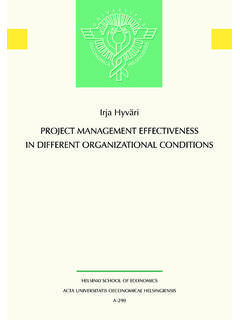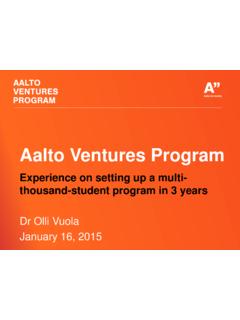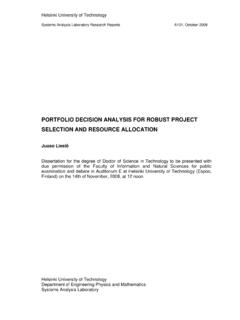Transcription of SME view on project marketing - Aalto
1 SME view on project marketing - case study in thecontext of institutional space businessSME business ManagementMaster's thesisJanne Lahtinen2013 Department of Management and International BusinessAalto UniversitySchool of BusinessPowered by TCPDF ( ) Aalto University, BOX 11000, 00076 of master s thesisAuthorJanne LahtinenTitle of thesisSME view on project marketing case study in the context of institutional spacebusinessDegreeMaster of Science in Economics and business AdministrationDegree programmeEntrepreneurshipThesis advisor(s)Jukka PartanenYear of approval2013 Number of pages88 LanguageEnglishAbstractProject business is one of the dominant modes in international business and it has increasingsignificance. The work is typically organised as projects, for example, in construction,shipbuilding, aerospace, and defence industries. However, the existing project marketing literaturehas concentrated almost exclusively on large firms.
2 Thus, the specific characteristics of Small andMedium-sized Enterprises (SMEs) and the influence of these characteristics on the projectmarketing practices of SMEs have not received much attention. The identified research gap is theproject marketing from SME and entrepreneurial perspective. The aim of this study is to providenew insight into this research gap. The objective is to identify and describe the marketing practicesthat SMEs apply to survive and succeed in project on the existing literature on project marketing and entrepreneurial marketing , aconceptual framework has been developed and applied to guide the empirical part of the framework combines the three-stage model of project marketing process (including independent of any project , pre-tender , and tender preparation stages) with the coreunderlying dimensions of entrepreneurial marketing ( opportunity orientation , market driving , customer intensity , resource leveraging , risk management , and innovativeness ).
3 The conducted study is a qualitative, multiple case study including five SMEs from fourdifferent European countries. The selected context is institutional space business , but the focushas been further narrowed down to the space business generated by the European space Agency(ESA).According to the results of this study, SMEs apply marketing practices that are in generalagreement with the developed conceptual framework. However, this study extends the currentunderstanding of the phenomenon beyond the existing literature and gives a more fine-grainedview of it. Also, this study indicates that the existing literature on project marketing is not fullyapplicable to SMEs. Furthermore, the existing literature on entrepreneurial marketing is notentirely applicable to project business , at least not in the studied context . The main empiricalfindings that extend the existing project marketing and entrepreneurial marketing literature areassociated with resource leveraging, risk management, evaluation of project opportunity, and thepolitical marketing , project marketing , project marketing process, Small andMedium-sized Enterprise, SME, space business , European space Agency, ESAACKNOWLEDGEMENTSThe preparation of this master s thesis as well as conducting the other studies in AaltoUniversity, School of business have been a highly interesting intellectual journey for aveteran engineer like me.
4 During this journey, several individuals have inspired me andprovided assistance. In the following, I would like to express my gratitude to of all, I would like to thank the supervisor of my master s thesis, Dr JukkaPartanen for his motivating and professional guidance during the thesis process, and forhis numerous suggestions to improve the thesis. Also, I would like to thank AssistantProfessor Amal Abbas from Cairo University for his insightful comments during thereview process. Mr Daniil Pokidko s help in practical study issues is acknowledged. Andin addition, I would like to thank the supervising professor, Prof. Paula Kyr fororganising the master s thesis process and for her helpful comments in the master s thesisseminars. But above all, I am most indebted to the five informants, who made the practicalpart of this research possible by accepting my interview my studies in the School of business , I have had the opportunity to attend theclasses of several inspiring teachers and lecturers.
5 Especially, I would like to thank thefollowing individuals: Ms Hannele Airio, Mr Michael Baker, Dr Elina Henttonen, Dr JoelHietanen, Prof. Paula Kyr , Prof. Petri Parvinen, Prof. Asta Salmi, Prof. John Schouten,Prof. Henrikki Tikkanen, Prof. Markku Virtanen, and Prof. Liisa V likangas. A specialthanks is given to Dr Tuomas Ahola, whose courseProject Marketinggave me theinspiration to select the subject of this thesis. A special word of appreciation goes also tomy student colleagues, with whom I have shared this intellectual journey, includingcountless group importantly, I would like to express my deepest gratitude to my wife U., who hassupported and encouraged me during this process. Finally, I would like to thank my familyand friends for OF business .. Supplier Firm .. space Agency .. System of to Tender .. OF 42 THEORETICAL FOUNDATIONS .. Characteristics of project business .
6 marketing Process .. Network .. marketing Logic, Strategies, and Orientation .. Driving .. Leveraging .. Management .. Creation .. of Any project Stage .. Preparation , , 374 RESULTS .. OF Orientation .. Driving .. Leveraging .. Management .. , Independent of any project Stage .. Orientation .. Driving .. Leveraging .. Management .. , Pre-Tender Stage .. Orientation .. Driving .. Leveraging .. Management .. , Tender Preparation Stage .. 615 SUMMARY .. OF 656 DISCUSSION AND CONCLUSIONS .. OF THESTUDY ANDPATHS 768 APPENDIX A: THE SCHEMA FOR 87 LIST OF TABLEST able 1. The literature-based conceptual framework of marketing practices of projectsupplier 29 Table 2. The key characteristics of the case firms and the 35 Table 3. The marketing practices of the case firms along the core dimensions ofentrepreneurial marketing during the independent of any project stage of 47 Table 4.
7 The marketing practices of the case firms along the core dimensions ofentrepreneurial marketing during the pre-tender stage of project 55 Table 5. The marketing practices of the case firms along the core dimensions ofentrepreneurial marketing during the tender preparation stage of project 62 Table 6. The summary of the findings: entrepreneurial marketing practices along theproject marketing 67 LIST OF FIGURESF igure 1. The project marketing process adapted from (Cova, Ghauri et al. 2002).. 7 Figure 2. An example of a sociogram: the network in construction business in the Loiretregion in France (Cova, Mazet et al. 1996).. 15 Figure 3. Sociogram of the business network from focal firm s perspective. Competitorsand relational development actions are not 7011 are and have been for millennia a significant part of both professional andpersonal human activity. This is evidenced by, , the outcome of numerous constructionprojects in modern and historic times, the oldest examples dating back even to pre-historictimes ( , Newgrange, Maeshove, Stonehenge).
8 Also, major developments in science andtechnology ( , Manhattan project for the development of atomic bomb, InternationalSpace Station) have been organised as business perspective of projects started to emerge already in the , internal and/or external projects are an integral part of any firm s business and oneof the dominant modes in international business in general. (Hadjikhani 1996, Skaates,Tikkanen 2003, Artto, Kujala 2008). Moreover, the significance of project business isincreasing in the society and business (Artto, Kujala 2008). For example, the work istypically organised as projects in the construction, shipbuilding, aerospace, and defenceindustries (Cova, Mazet et al. 1994, Bonaccorsi, Pammolli et al. 1996, Ahola 2009). Theconstruction business alone generated 655 B 1or of the gross domestic product inthe European Union in 2010 (Eurostat European Commission 2011) and the turnover ofthe European aerospace and defence industries was 186 B in 2011 (ASD Communicationand Information Team 2012).
9 Well known Finnish project supplier firms are, , P yry(in engineering), Outotech (in technology solutions), Patria (in defence systems), YIT (inconstruction), and STX Finland (in shipbuilding).Despite the fact that project business is a significant element in the global economy,and that selling projects is an essential part of this business , project marketing as aresearch field is fairly small. In fact, there are only a handful of researchers in this field.(Tikkanen, Aspara 2008). In addition, the existing project marketing literature hasconcentrated almost exclusively on large firms (see, , Cova, Ghauri et al. 2002, Jalkala,Cova et al. 2010). There are only very few exceptions, including (Alajoutsij rvi,Mannermaa et al. 2000, Cova, Salle et al. 2000). Hence, the research on project marketingfrom entrepreneurial and SME perspective is important, since small firms usually actdifferently than large firms when they encounter the same conditions (Raymond, Bergeronet al.)
10 1998).Similarly, marketing is critically important for entrepreneurial success (Hills, Hultmanet al. 2008). So far, however, marketing research has mostly focused on large corporationswith large resources, while small, entrepreneurial organisations have received much lessattention. Yet, there are significant differences in the marketing between these twodifferent kinds of firms (Hills, Hultman et al. 2008).Applying marketing models that have been developed for large firms (so-called textbook models ) to SMEs (Small and Medium-sized Enterprises) has been criticized,since SMEs have unique characteristics compared to large corporations, such as limitedresources, lack of specialist expertise, and limited impact in the marketplace (Gilmore,1 The definition of billion is applied here, , 1 B = 109 2 Carson et al. 2001). These unique characteristics influence or even determine themarketing practises of SMEs: marketing of SMEs is likely to be haphazard, informal,loose, unstructured, spontaneous, reactive, built upon and conforming to industry norms,and following effectual (non-predictive) logic (Carson, Gilmore et al.












